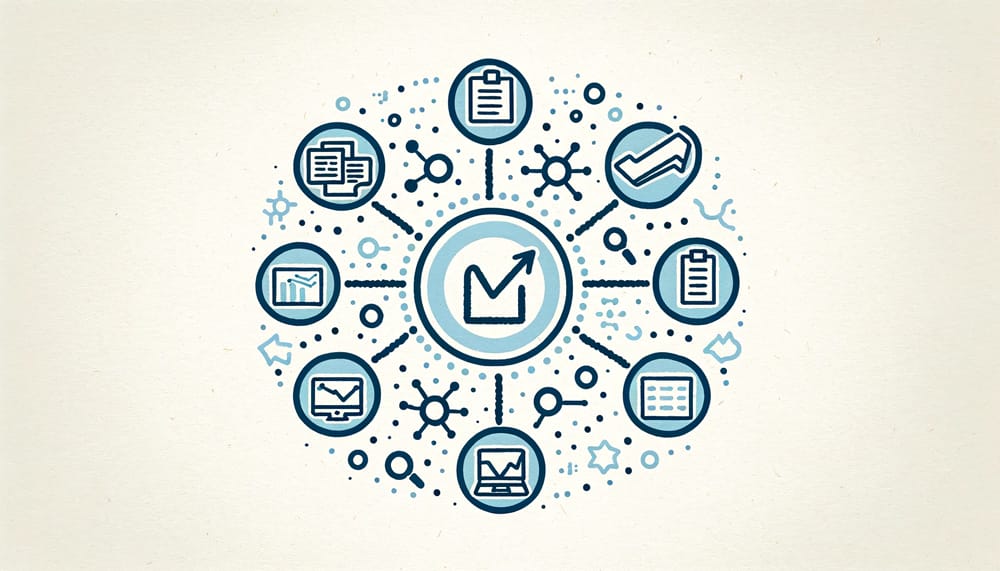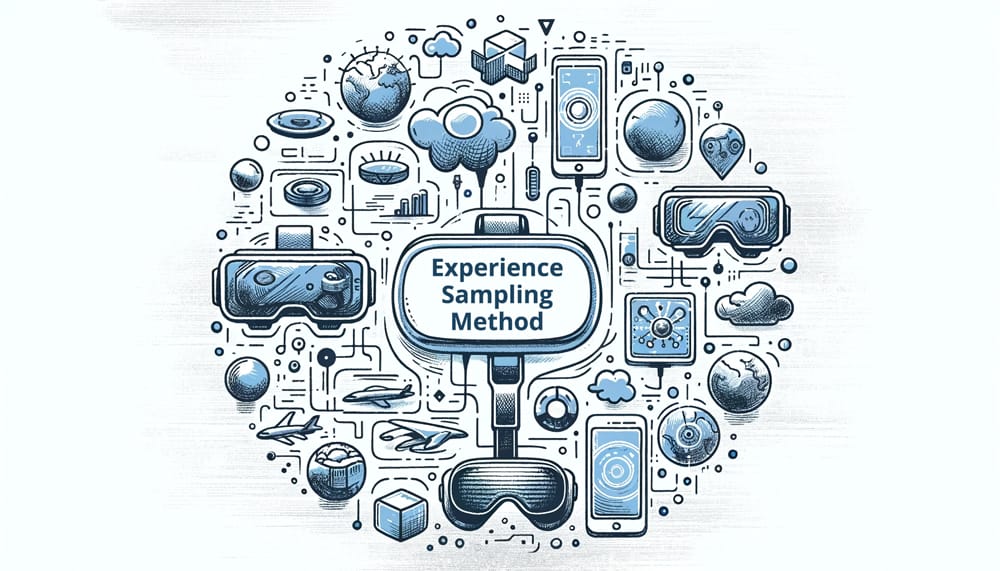Introduction
In the realm of research methodologies, the Experience Sampling Method (ESM) and Ecological Momentary Assessment (EMA) stand out for their unique approach to data collection in real-world settings. These methods have revolutionized how researchers gather data, offering insights into human behavior, thoughts, and feelings as they occur in natural environments. This article aims to dissect and compare these two methodologies, highlighting their nuances and applications in various research domains.
ESM and EMA: A Brief Overview
-
- ESM: Originally conceptualized in the 1970s, the Experience Sampling Method is a research technique used to collect data about individuals’ behaviors and experiences in real time. This method typically involves prompting participants to report on their current activities, thoughts, and feelings at random intervals throughout the day. For further insights into the foundational aspects of ESM, Introduction to Experience Sampling Method (ESM) provides a comprehensive overview.
-
- EMA: Similarly, Ecological Momentary Assessment, emerging around the same time as ESM, focuses on assessing individuals’ behaviors and experiences in their natural environments. This method emphasizes capturing data that are ecologically valid and reflective of participants’ typical experiences. Get started with Ecological Momentary Assessment (EMA) through our guide, Introduction to Ecological Momentary Assessment (EMA). This article provides a foundational overview, perfect for newcomers to EMA research.
Both ESM and EMA are grounded in the idea that gathering data in the moment can reduce recall bias and provide a more accurate representation of everyday life.
“The richness of life does not lend itself to retrospective summaries,” stated Reed Larson, a pioneer in the use of ESM. This sentiment encapsulates the core philosophy behind these methodologies: capturing life as it is lived.
Importance and Objectives
ESM and EMA hold significant importance in modern research due to their ability to:
- Capture data in real-world contexts
- Provide insights into patterns over time
- Offer a nuanced understanding of behaviors and experiences
The primary objectives of this article are to:
- Compare and contrast ESM and EMA in terms of methodology, applications, and outcomes.
- Highlight their strengths and limitations in various research settings.
- Provide insights into the future trajectory of these research methods.
In the following sections, we will delve deeper into the historical development of ESM and EMA, their definitions, applications, and key differences, providing a comprehensive understanding of these two influential research methodologies. Additionally, for those new to ESM or seeking a foundational understanding, Introduction to Experience Sampling Method (ESM) is an essential read.
Historical Context and Development of ESM and EMA

Early Developments
The genesis of the Experience Sampling Method (ESM) and Ecological Momentary Assessment (EMA) dates back to the 1970s, a period marked by a growing interest in understanding human behavior in naturalistic settings. Pioneers in this field recognized the limitations of traditional survey methods, which often relied on retrospective accounts, and sought more immediate and contextually relevant data collection techniques.
-
- ESM’s Inception: Developed by psychologists Mihaly Csikszentmihalyi and Reed Larson, ESM was initially designed to study the phenomenon of flow – a state of complete immersion and enjoyment in an activity. Early ESM studies utilized pagers and paper diaries, where participants would record their experiences in real time.
-
- EMA’s Emergence: Parallel to the development of ESM, EMA evolved with a slightly different focus. It aimed at assessing individuals’ behaviors and psychological states in their natural environments, with an emphasis on ecological validity.
Key Researchers and Milestones
Several researchers have played crucial roles in the evolution of ESM and EMA:
-
- Mihaly Csikszentmihalyi: Known as the father of ESM, his work on flow and happiness significantly influenced the method’s direction.
-
- Reed Larson: His contributions in adolescent psychology utilized ESM to gain insights into the daily lives of teenagers.
-
- Arthur Stone and Saul Shiffman: These researchers were instrumental in advancing EMA, particularly in the context of health psychology.
Milestones in Development:
-
- The 1980s saw the integration of electronic beepers in ESM, enhancing the method’s effectiveness.
-
- The 1990s witnessed a shift towards digital diaries and handheld computers in both ESM and EMA.
-
- The 2000s brought the advent of smartphone apps, greatly expanding the reach and capabilities of these methods.
Convergence and Divergence Over Time
While both ESM and EMA originated from a common desire to study behavior in natural settings, their paths diverged based on their focus areas and applications. ESM became more associated with the study of psychological states and subjective experiences, while EMA found extensive use in health research, tracking symptoms and behaviors related to physical and mental health conditions.
Despite these divergences, both methods have seen a convergence in recent years, particularly with the advent of smartphone technology. This has blurred the lines between ESM and EMA, as both methods now increasingly utilize similar digital tools for data collection.
In summarizing their historical development, Saul Shiffman, a prominent figure in EMA research, noted, “The real power of these methods lies in their ability to capture life as it happens, providing a window into the lived experience that was previously inaccessible.”
Defining Experience Sampling Method (ESM)
Definition and Fundamental Principles of ESM: Experience Sampling Method (ESM), also known as the diary method, is a research technique that involves collecting data from participants as they go about their daily lives. This method is grounded in the principle of capturing immediate experiences to minimize recall bias and enhance the ecological validity of the data. ESM requires participants to report on their thoughts, feelings, behaviors, and environment at random or predetermined intervals. It relies on the assumption that the best way to understand human behavior and experience is through real-time and real-world data collection.
Typical Applications and Examples: ESM is widely used in psychology, particularly in studying well-being, mood disorders, and social interactions. For instance, in mental health research, ESM can provide insights into the daily lives of individuals with depression, capturing fluctuations in mood and identifying triggers of depressive episodes. In organizational psychology, ESM has been employed to study job satisfaction, tracking employees’ experiences and stress levels throughout the workday.
Strengths and Limitations of ESM: One of the primary strengths of ESM is its ability to provide high ecological validity. By gathering data in real-world settings, ESM captures the complexity and dynamism of human experiences. It also allows for the examination of within-person variability and patterns over time. However, ESM is not without its limitations. Participant burden is a significant concern, as frequent reporting can be tedious and intrusive, potentially leading to non-compliance or dropout. Additionally, the method can be influenced by the reactivity effect, where the act of self-reporting influences the behavior or experiences being measured. Despite these challenges, ESM remains a valuable tool for understanding the nuances of human experience in naturalistic settings. For further insights into the foundational aspects of ESM, Introduction to Experience Sampling Method (ESM) provides a comprehensive overview.
Defining Ecological Momentary Assessment (EMA)

Definition and Core Principles of EMA:
Ecological Momentary Assessment (EMA) is a research method designed to capture individuals’ behaviors and experiences in real time and in their natural environments. Similar to ESM, the core principle of EMA is to reduce recall bias and enhance ecological validity. However, EMA typically focuses more on the assessment of current states or behaviors rather than reflective experiences. It involves asking participants to report on their immediate feelings, actions, or surroundings at random or specified times.
Common Applications and Case Studies:
EMA is extensively used in health psychology, behavioral medicine, and clinical research. For example, it has been instrumental in addiction studies, where EMA is used to track cravings and contextual factors leading to substance use. In chronic illness management, EMA provides insights into symptom patterns, medication adherence, and lifestyle factors impacting health outcomes. The method’s real-time data collection is particularly valuable in understanding dynamic processes like pain management, eating behaviors, and stress responses.
Advantages and Challenges of EMA:
EMA offers several advantages, including high ecological validity, the ability to capture temporal dynamics of experiences, and reducing recall bias. It is particularly useful in studying phenomena that are difficult to observe directly or that vary significantly over time. On the downside, EMA can be demanding for participants, requiring frequent and immediate responses, which can lead to response fatigue and potential dropout. The accuracy of EMA data can also be influenced by participants’ willingness and ability to report honestly and promptly. Despite these challenges, EMA remains a powerful tool for capturing the intricacies of human behavior and experiences in real-world settings.
Comparative Analysis

Similarities between ESM and EMA:
Both the Experience Sampling Method (ESM) and Ecological Momentary Assessment (EMA) share a fundamental goal: to capture human experiences and behaviors in their natural context as they occur. These methods strive to minimize retrospective bias, enhance ecological validity, and provide a more accurate representation of everyday life. In both approaches, participants are prompted to report their feelings, thoughts, or behaviors at random or pre-defined times, typically using portable devices or smartphones.
For further insights and practical tips on ESM data analysis, exploring resources like Analyzing ESM Data: A Guide can be immensely beneficial.
Distinctive Features and Methodological Differences:
Despite their similarities, ESM and EMA differ in focus and application. ESM is more reflective, asking participants to report on recent experiences or states. In contrast, EMA tends to be more immediate, focusing on the current moment or very recent behavior. The choice of method often depends on the research question: ESM is preferred for studies exploring fluctuating experiences or states over time, while EMA is more suited for capturing immediate reactions or behaviors in response to specific stimuli.
Another key difference lies in their implementation. ESM often involves a more random sampling of experiences throughout the day, while EMA might target specific contexts or conditions, such as stressors or environmental factors.
How the Choice Between ESM and EMA Affects Research Outcomes:
The selection of ESM or EMA can significantly influence research outcomes. ESM, with its reflective nature, is adept at capturing complex emotional states or cognitive processes over time. It can provide insights into patterns and fluctuations in mood, well-being, or social interactions. EMA, on the other hand, is highly effective in studies where the immediate context is critical, such as in addiction research, where real-time assessment of cravings and context can lead to more accurate predictions and interventions.
In summary, while both ESM and EMA offer valuable insights into human behavior and experiences, their effectiveness largely depends on the research question at hand. Understanding their distinctive features and methodological differences is crucial for researchers to choose the appropriate approach for their specific study needs.
Technological Integration and Advancements

The Role of Technology in Shaping ESM and EMA:
The evolution of the Experience Sampling Method (ESM) and Ecological Momentary Assessment (EMA) has been significantly influenced by advancements in technology. Initially reliant on paper diaries and pagers, these methods have evolved with the advent of digital technology. The integration of smartphones, wearable devices, and specialized apps has revolutionized how data is collected, increasing the ease of use for participants and researchers alike. This technological shift has enabled more sophisticated data collection, including passive data gathering (like GPS location and physical activity tracking), which can provide richer context to self-reported data.
Recent Technological Innovations and Their Impact:
Recent innovations in technology have further refined ESM and EMA methodologies. The development of more intuitive and interactive smartphone applications has enhanced participant engagement and compliance. Features like customizable notifications, in-app questionnaires, and real-time data syncing have made these methods more efficient and user-friendly. Additionally, the integration of artificial intelligence and machine learning algorithms allows for the analysis of large datasets, uncovering patterns and correlations that were previously difficult to detect.
Wearable technology, such as smartwatches and fitness trackers, has also played a crucial role. These devices provide continuous physiological data like heart rate, sleep patterns, and activity levels, offering a more comprehensive picture of participants’ daily lives and health.
Future Trends in Digital Integration:
Looking ahead, the future of ESM and EMA is poised to be shaped by further technological advancements. The potential integration of virtual and augmented reality could offer new ways to assess and understand human behavior and experiences in simulated environments. The growing field of the Internet of Things (IoT) promises to interconnect various devices, providing a more holistic view of participants’ environments and interactions.
Privacy and data security will remain paramount, especially as data collection becomes more pervasive and integrated into everyday devices. Ensuring ethical data use and protecting participant confidentiality in this digital era will be a critical focus for researchers employing these methods.
In conclusion, technology has been a driving force in the evolution of ESM and EMA, offering new possibilities for data collection and analysis. As technology continues to advance, it will be crucial for researchers to embrace these innovations while maintaining ethical standards and participant privacy. The future of ESM and EMA is intertwined with the trajectory of technological progress, promising even more insightful and comprehensive research capabilities.
For a comprehensive understanding of the latest technological innovations in ESM, resources like Technological Innovations in ESM Data Collection offer in-depth information and insights.
Practical Applications and Case Studies

Highlighting Key Studies Using ESM:
The Experience Sampling Method (ESM) has been instrumental in various research domains, particularly in psychology, health studies, and social sciences. For instance, in a notable study on mood dynamics, ESM was used to track participants’ emotional states multiple times a day over several weeks. This study provided valuable insights into the fluctuating nature of mood and its triggers in everyday life. In another significant application, ESM was utilized in a health research project to monitor the daily activities and symptoms of patients with chronic illnesses. This approach enabled a better understanding of symptom patterns and their impact on patients’ daily lives, contributing to more personalized healthcare strategies.
Notable Research Employing EMA:
Ecological Momentary Assessment (EMA) has been extensively used in behavioral and medical research. One groundbreaking study employed EMA to understand the eating behaviors and triggers of obesity in real-time, revealing critical insights into impulsive eating and the environmental factors influencing it. In another application, EMA was used in a mental health study to assess the real-time effects of stress on individuals with anxiety disorders. This research provided a more nuanced understanding of anxiety triggers and the effectiveness of coping strategies in naturalistic settings.
Comparative Analysis of Outcomes:
The outcomes of studies using ESM and EMA often highlight the methods’ strengths and limitations. ESM’s frequent sampling provides a detailed chronology of experiences and states, making it ideal for studies focused on dynamics and changes over time. EMA, with its emphasis on the ecological validity, is particularly effective in studies where the context of behavior or experience is crucial. For instance, EMA studies in environmental psychology have shed light on how different settings influence mood and behavior.
In comparing outcomes, it’s evident that both methods have contributed significantly to understanding human behavior and experiences in natural settings. ESM’s strength lies in capturing the temporal dimension of experiences, while EMA excels in contextualizing these experiences in the participant’s environment. Together, these methods have enriched research findings, offering a more comprehensive view of human behavior and experiences than traditional research methods.
In conclusion, the practical applications of ESM and EMA in various fields highlight their versatility and effectiveness. The case studies demonstrate how these methods have been pivotal in advancing our understanding of complex psychological, health, and social phenomena. As these methods continue to evolve, their contribution to empirical research is likely to become even more significant, providing deeper insights into the nuances of human experiences.
For more detailed methodologies on adjusting frequency and timing in ESM, Analyzing ESM Data: A Step-by-Step Guide can be a valuable resource.
Challenges and Ethical Considerations

Addressing Participant Burden and Compliance in Both Methods:
One of the significant challenges in using both the Experience Sampling Method (ESM) and Ecological Momentary Assessment (EMA) is managing participant burden. These methods often require participants to respond to frequent prompts or questions throughout their day, which can be intrusive and potentially disruptive. Ensuring participant compliance, therefore, becomes a crucial aspect of research design. Researchers must balance the need for detailed data with the practicality and comfort of the participants. Strategies like optimizing the frequency of prompts and ensuring user-friendly data collection methods are employed to mitigate these concerns.
Learn the art of selecting the right participants for Experience Sampling Method (ESM) studies in our informative guide, How to Select Participants for an Experience Sampling Method (ESM) Study: Sampling Techniques. This guide delves into various sampling techniques, providing insights and strategies to help researchers ensure effective participant engagement in ESM research.
Ethical Issues in Real-Time Data Collection:
Both ESM and EMA involve collecting data in real-time, often in the natural environment of the participant. This raises several ethical considerations. Informed consent becomes complex when participants are required to report on their experiences as they occur in various settings, some of which might be sensitive or private. Researchers must ensure that participants fully understand what they are consenting to and have the right to withdraw at any time. Additionally, the real-time nature of these methods means that researchers might inadvertently capture sensitive information, raising questions about data handling, confidentiality, and the participants’ right to privacy. Ensuring the privacy and confidentiality of participant data, as highlighted in Ethical Considerations in ESM Research.
Privacy and Data Security Concerns:
With the increasing integration of technology in ESM and EMA, concerns about data privacy and security have become more pronounced. The use of smartphones and digital devices for data collection means that vast amounts of personal and sometimes sensitive data are being collected, stored, and transmitted. Ensuring the security of this data against unauthorized access or breaches is a paramount concern. This involves using secure data transmission protocols, robust data encryption, and ensuring compliance with data protection laws and regulations. Researchers must also be transparent with participants about how their data will be used, stored, and protected.
In conclusion, while ESM and EMA offer invaluable insights into human experiences and behavior, they also bring a range of challenges and ethical considerations that must be carefully navigated. Addressing participant burden and compliance is crucial for the integrity of the research, while ethical considerations around informed consent, privacy, and data security are paramount in respecting the rights and wellbeing of participants. As these methodologies continue to evolve, particularly with technological advancements, ongoing attention to these ethical and practical challenges will be essential to maintain the trust and engagement of participants and the validity of the research outcomes.
Conclusion and Future Perspectives
In summing up the comparative analysis of the Experience Sampling Method (ESM) and Ecological Momentary Assessment (EMA), we can appreciate the unique contributions and limitations of each method in understanding human experiences and behaviors in real-time and naturalistic settings. While both methodologies share common goals and approaches, their subtle differences in application and execution cater to various research needs and contexts.
Key Takeaways from the Comparative Analysis:
-
- Both ESM and EMA are instrumental in capturing dynamic and contextually rich data, offering insights that more traditional research methods may miss.
-
- ESM’s focus on introspective, subjective experiences complements EMA’s broader approach to capturing both subjective and objective data.
-
- Technological advancements have significantly enhanced the capabilities of both methods, allowing for more efficient, accurate, and comprehensive data collection.
Potential Future Developments:
Looking forward, the integration of emerging technologies like artificial intelligence, machine learning, and advanced biometric sensors holds promise for further refining these methods. These advancements could lead to more nuanced data analysis, real-time feedback, and even predictive modeling of human behavior. Additionally, the increasing focus on user-friendly and minimally invasive technologies may help in reducing participant burden and enhancing compliance.
Final Thoughts on the Importance of ESM and EMA in Research:
ESM and EMA stand as pivotal tools in psychological, sociological, and health-related research. Their ability to capture the ebb and flow of daily life provides researchers with a more authentic and holistic understanding of human experiences. As we continue to embrace and integrate new technologies, the potential for these methods to contribute to our understanding of complex human behaviors and experiences is boundless. This ongoing evolution will surely open new avenues for research and practical applications, significantly contributing to our knowledge of human nature and behavior.
You Might Also Be Interested:
Delve into our comprehensive ESM Article Collection for insightful perspectives on Experience Sampling Method (ESM).
See our article Best Tools for Experience Sampling Method in 2024 to discover the top tools in the field.
Learn how the advanced features of Fibion Insight can aid your ESM research.
Planning an ESM study? For a chat with our ESM expert, book a session with Dr. Miriam Cabrita.
Frequently asked questions in this topic
What are ESM and EMA in research methodologies?
+
ESM and EMA are methods for collecting data about individual behaviors and experiences in real-time and natural environments. ESM focuses on introspective experiences, while EMA emphasizes immediate states or behaviors.
How do ESM and EMA differ in focus and application?
+
ESM is more reflective, focusing on recent experiences or states, while EMA is immediate, targeting current behaviors or feelings. ESM is used in psychological studies, whereas EMA is common in health research.
What technological advancements have influenced ESM and EMA?
+
Smartphones, wearable devices, and specialized apps have revolutionized ESM and EMA, enabling sophisticated data collection like passive data gathering and real-time feedback.
What are some practical applications of ESM and EMA?
+
ESM has been used in studies on mood dynamics and chronic illness management, while EMA is utilized in addiction studies and chronic illness symptom tracking.
What challenges and ethical considerations arise with ESM and EMA?
+
Challenges include managing participant burden and ensuring compliance. Ethical considerations revolve around informed consent, data privacy, and security.
What is the future outlook for ESM and EMA in research?
+
The integration of AI, machine learning, and advanced biometric sensors is expected to refine these methods, leading to more comprehensive and nuanced data analysis.


 Delve into our comprehensive
Delve into our comprehensive  See our article
See our article  Learn how the advanced features of
Learn how the advanced features of  Planning an ESM study? For a chat with our ESM expert,
Planning an ESM study? For a chat with our ESM expert, 








